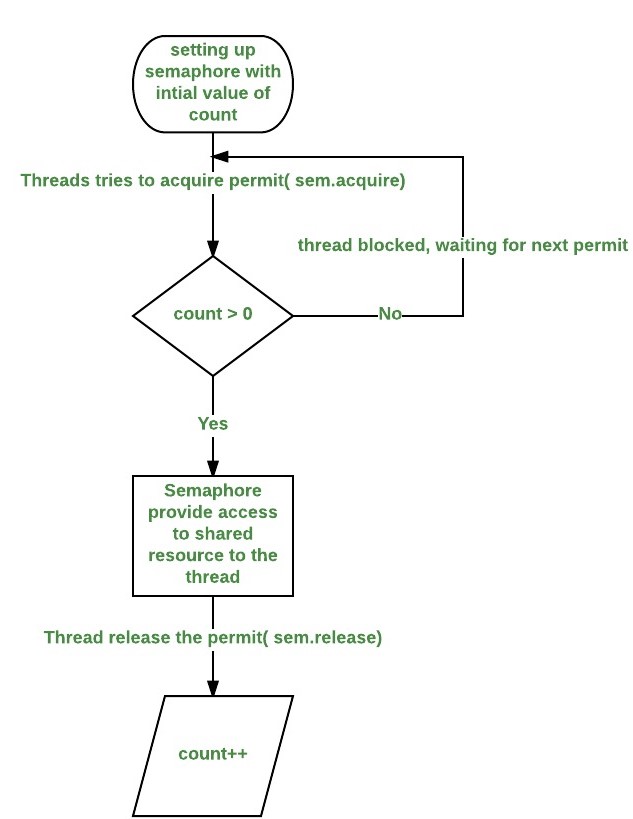Java中的信号量
信号量通过使用计数器来控制对共享资源的访问。如果计数器大于零,则允许访问。如果为零,则拒绝访问。计数器计数的是允许访问共享资源的许可。因此,要访问资源,线程必须从信号量中获得许可。
信号量的工作
通常,要使用信号量,想要访问共享资源的线程会尝试获取许可。
- 如果信号量的计数大于零,则线程获得许可,这会导致信号量的计数减少。
- 否则,线程将被阻塞,直到获得许可为止。
- 当线程不再需要访问共享资源时,它会释放许可,这会导致信号量的计数增加。
- 如果有另一个线程在等待许可,则该线程将在那时获得许可。
Java在实现此机制的Java.util.concurrent包中提供了Semaphore类,因此您不必实现自己的信号量。
流程图 : 
Semaphore 类中的构造函数: Semaphore 类中有两个构造函数。
Semaphore(int num)
Semaphore(int num, boolean how)
这里, num指定初始许可计数。因此,它指定了任何时候可以访问共享资源的线程数。如果是 1,那么任何时候只有一个线程可以访问资源。默认情况下,所有等待的线程都以未定义的顺序被授予许可。通过将how设置为 true,您可以确保等待线程按照它们请求访问的顺序被授予许可。
使用信号量作为锁(防止竞争条件)
我们可以使用信号量来锁定对资源的访问,每个想要使用该资源的线程必须首先调用acquire() ,然后才能访问资源以获取锁。当线程用完资源后,它必须调用release()来释放锁。下面是一个例子来证明这一点:
// java program to demonstrate
// use of semaphores Locks
import java.util.concurrent.*;
//A shared resource/class.
class Shared
{
static int count = 0;
}
class MyThread extends Thread
{
Semaphore sem;
String threadName;
public MyThread(Semaphore sem, String threadName)
{
super(threadName);
this.sem = sem;
this.threadName = threadName;
}
@Override
public void run() {
// run by thread A
if(this.getName().equals("A"))
{
System.out.println("Starting " + threadName);
try
{
// First, get a permit.
System.out.println(threadName + " is waiting for a permit.");
// acquiring the lock
sem.acquire();
System.out.println(threadName + " gets a permit.");
// Now, accessing the shared resource.
// other waiting threads will wait, until this
// thread release the lock
for(int i=0; i < 5; i++)
{
Shared.count++;
System.out.println(threadName + ": " + Shared.count);
// Now, allowing a context switch -- if possible.
// for thread B to execute
Thread.sleep(10);
}
} catch (InterruptedException exc) {
System.out.println(exc);
}
// Release the permit.
System.out.println(threadName + " releases the permit.");
sem.release();
}
// run by thread B
else
{
System.out.println("Starting " + threadName);
try
{
// First, get a permit.
System.out.println(threadName + " is waiting for a permit.");
// acquiring the lock
sem.acquire();
System.out.println(threadName + " gets a permit.");
// Now, accessing the shared resource.
// other waiting threads will wait, until this
// thread release the lock
for(int i=0; i < 5; i++)
{
Shared.count--;
System.out.println(threadName + ": " + Shared.count);
// Now, allowing a context switch -- if possible.
// for thread A to execute
Thread.sleep(10);
}
} catch (InterruptedException exc) {
System.out.println(exc);
}
// Release the permit.
System.out.println(threadName + " releases the permit.");
sem.release();
}
}
}
// Driver class
public class SemaphoreDemo
{
public static void main(String args[]) throws InterruptedException
{
// creating a Semaphore object
// with number of permits 1
Semaphore sem = new Semaphore(1);
// creating two threads with name A and B
// Note that thread A will increment the count
// and thread B will decrement the count
MyThread mt1 = new MyThread(sem, "A");
MyThread mt2 = new MyThread(sem, "B");
// stating threads A and B
mt1.start();
mt2.start();
// waiting for threads A and B
mt1.join();
mt2.join();
// count will always remain 0 after
// both threads will complete their execution
System.out.println("count: " + Shared.count);
}
}
输出:
Starting A
Starting B
A is waiting for a permit.
B is waiting for a permit.
A gets a permit.
A: 1
A: 2
A: 3
A: 4
A: 5
A releases the permit.
B gets a permit.
B: 4
B: 3
B: 2
B: 1
B: 0
B releases the permit.
count: 0
注意:上述程序的不同执行输出可能不同,但计数变量的最终值将始终保持为 0。
上述程序说明:
- 该程序使用信号量来控制对count变量的访问,该变量是 Shared 类中的静态变量。 Shared.count由线程 A 递增 5 次,由线程 B 递减 5 次。为了防止这两个线程同时访问 Shared.count,只有在从控制信号量获得许可后才允许访问。访问完成后,许可被释放。这样,一次只有一个线程可以访问 Shared.count,如输出所示。
- 注意在 MyThread 类的 run() 方法中对 sleep() 的调用。它用于“证明”对 Shared.count 的访问是由信号量同步的。在 run() 中,对 sleep() 的调用会导致调用线程在每次访问 Shared.count 之间暂停。这通常会使第二个线程运行。但是,由于信号量,第二个线程必须等到第一个线程释放许可,这仅在第一个线程的所有访问都完成后才会发生。因此,Shared.count 首先由线程 A 递增五次,然后由线程 B 递减五次。在汇编代码中递增和递减不会混合。
- 如果不使用信号量,两个线程对Shared.count的访问将同时发生,并且增量和减量将混合在一起。要确认这一点,请尝试注释掉对acquire( )和release( )的调用。运行程序时,您会看到对 Shared.count 的访问不再同步,因此您不会总是得到计数值 0。
下一篇: Java Java类